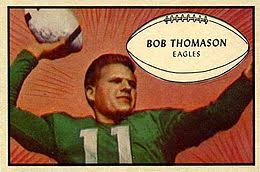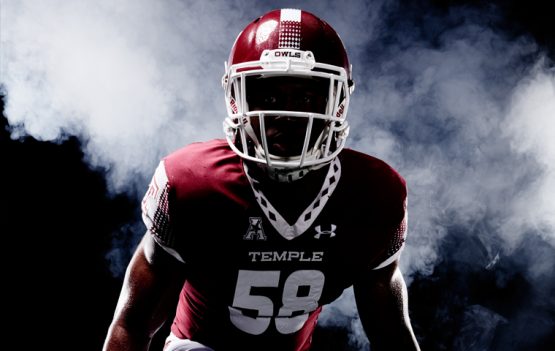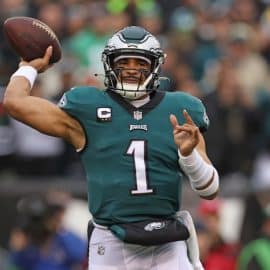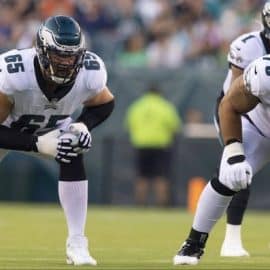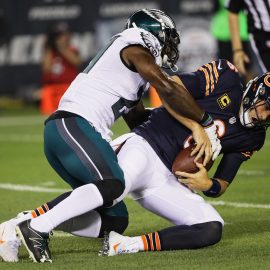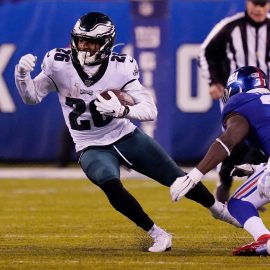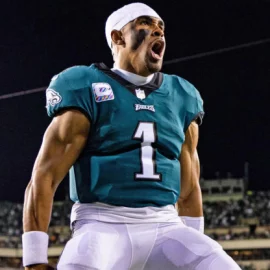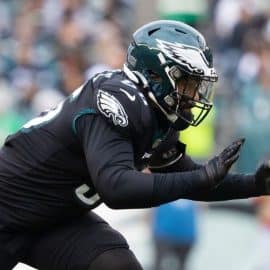Every now and then I like to throw in a little historical perspective on the kind of football we now expect from our Eagles. Over time we and the rest of the NFL have devalued the run game in favor of the passing game. That is partly due to natural evolution, but also partly due to the incessant rules changes which have encouraged more passing plays—because big throws and beautiful catches fuel the audience ratings and increase scoring, which in today’s game means “mo’ money” for the NFL.
Right now QB passer ratings are through the roof and at an all-time high based upon the first four games of the 2018 season:
Net Passing Yards Leaders
| RK | TEAM | ATT | COMP | PCT | YDS | YDS/A | LONG | TD | INT | SACK | YDSL | RATE | YDS/G |
| 1 | Tampa Bay | 149 | 103 | 69.1 | 1453 | 10.1 | 75 | 12 | 7 | 9 | 48 | 108.9 | 363 |
| 2 | LA Rams | 135 | 97 | 71.9 | 1373 | 10.4 | 70 | 11 | 2 | 5 | 33 | 126.3 | 343 |
| 3 | Pittsburgh | 186 | 119 | 64.0 | 1355 | 7.6 | 75 | 8 | 5 | 9 | 59 | 90.2 | 339 |
| 4 | Oakland | 169 | 120 | 71.0 | 1332 | 8.1 | 66 | 6 | 7 | 8 | 41 | 89.7 | 333 |
| 5 | Minnesota | 189 | 131 | 69.3 | 1309 | 7.3 | 75 | 10 | 2 | 13 | 78 | 103.7 | 327 |
| 6 | Atlanta | 145 | 99 | 68.3 | 1259 | 9.1 | 75 | 10 | 2 | 10 | 57 | 114.0 | 315 |
| 7 | New Orleans | 163 | 123 | 75.5 | 1255 | 8.0 | 42 | 8 | 0 | 6 | 50 | 114.7 | 314 |
| 8 | Baltimore | 175 | 111 | 63.4 | 1231 | 7.3 | 71 | 8 | 2 | 10 | 45 | 95.8 | 308 |
| 9 | Kansas City | 138 | 90 | 65.2 | 1189 | 8.7 | 58 | 14 | 0 | 5 | 11 | 126.5 | 297 |
| 10 | Detroit | 171 | 114 | 66.7 | 1170 | 7.1 | 67 | 8 | 6 | 6 | 46 | 88.2 | 293 |
| 11 | Houston | 148 | 92 | 62.2 | 1162 | 8.4 | 39 | 7 | 4 | 17 | 84 | 93.5 | 291 |
| 12 | Cincinnati | 157 | 103 | 65.6 | 1132 | 7.6 | 49 | 11 | 6 | 7 | 65 | 95.9 | 283 |
| 13 | LA Chargers | 147 | 100 | 68.0 | 1115 | 7.9 | 42 | 11 | 2 | 6 | 41 | 110.8 | 279 |
| 14 | Green Bay | 164 | 103 | 62.8 | 1076 | 7.2 | 75 | 7 | 2 | 14 | 109 | 93.7 | 269 |
| 15 | Jacksonville | 150 | 97 | 64.7 | 1066 | 7.3 | 67 | 7 | 3 | 6 | 29 | 93.6 | 267 |
| 16 | Indianapolis | 187 | 125 | 66.8 | 1060 | 6.0 | 42 | 9 | 3 | 9 | 66 | 92.2 | 265 |
| 17 | Philadelphia | 170 | 113 | 66.5 | 982 | 6.3 | 56 | 4 | 2 | 14 | 87 | 86.6 | 246 |
| 18 | Denver | 141 | 87 | 61.7 | 940 | 7.0 | 43 | 3 | 6 | 9 | 48 | 72.1 | 235 |
| 19 | NY Giants | 151 | 112 | 74.2 | 929 | 7.0 | 37 | 4 | 1 | 15 | 126 | 99.1 | 232 |
| 20 | San Francisco | 126 | 76 | 60.3 | 909 | 8.1 | 82 | 7 | 5 | 14 | 107 | 87.9 | 227 |
| 21 | New England | 135 | 87 | 64.4 | 881 | 6.8 | 55 | 9 | 4 | 6 | 37 | 94.0 | 220 |
| 22 | Chicago | 130 | 91 | 70.0 | 878 | 7.3 | 47 | 8 | 3 | 10 | 67 | 101.6 | 220 |
| 23 | Cleveland | 148 | 79 | 53.4 | 853 | 6.5 | 59 | 4 | 4 | 16 | 105 | 71.3 | 213 |
| 24 | Tennessee | 124 | 78 | 62.9 | 813 | 7.0 | 66 | 4 | 4 | 7 | 50 | 80.8 | 203 |
| 25 | NY Jets | 127 | 73 | 57.5 | 805 | 6.8 | 44 | 4 | 5 | 10 | 63 | 72.6 | 201 |
| 26 | Miami | 100 | 70 | 70.0 | 792 | 8.7 | 75 | 9 | 3 | 8 | 82 | 114.3 | 198 |
| 27 | Seattle | 121 | 76 | 62.8 | 786 | 7.3 | 66 | 7 | 3 | 16 | 102 | 94.0 | 197 |
| 28 | Washington | 96 | 66 | 68.8 | 736 | 8.0 | 52 | 4 | 1 | 6 | 31 | 102.2 | 245 |
| 29 | Dallas | 115 | 71 | 61.7 | 666 | 6.5 | 64 | 4 | 2 | 14 | 87 | 85.2 | 167 |
| 30 | Carolina | 95 | 64 | 67.4 | 611 | 6.8 | 51 | 5 | 1 | 6 | 35 | 99.7 | 204 |
| 31 | Arizona | 114 | 69 | 60.5 | 567 | 5.4 | 35 | 3 | 5 | 8 | 49 | 65.5 | 142 |
| 32 | Buffalo | 121 | 60 | 49.6 | 530 | 5.7 | 57 | 2 | 6 | 21 | 160 | 52.0 | 133 |
Everybody’s throwing the rock (with the exception of the Buffalo Bills) at a record-setting rate.
It was different back in the day. Passer ratings were pathetically low in the early days of Eagles football. It wasn’t that important. It was a different kind of mindset on offense.
In 1933, Red Kirkman led the Eagles with 22 completions in 73 attempts for 354 yards, 2 TD’s and 13 INT’s. His passer rating was 17.0.
In 1936, Dave Smukler raised the bar with 21 completions in 68 attempts for 3 TD’s and only 6 INT’s, and a much improved passer rating of 26.9.
In 1938, Smukler outdid himself with 42-for-102, 524 yards, 7 TD’s against 8 INT’s…a 48.0 rating.
Davey O’Brien came on the scene in 1939 as the 1st Round draft pick of the Eagles, an All-American who signed for $12,000 a year and a percentage of the gate. O’Brien in a 1-9-1 season put up the revolutionary passing numbers of 99-for-201, 1324 yards, 6 TD’s and (gulp!) 17 INT’s. That was good for a 45.3 rating.
In 1941, Tommy Thompson took over at QB for the Eagles. Although legally blind in one eye (and the reason he wasn’t drafted for WWII), Thompson went 86-for-162 for 959 yards, 8 TD’s and 14 INT’s, and a passer rating of 51.4.
Thompson posted similar numbers in 1942, then the Steelers merged with the Eagles in 1943 (forming the “Steagles”) and Thompson got demoted in favor of some cat named Roy Zimmerman, who finished a 5-4-1 season with a 44.0 rating.
By 1946, Thompson was back at the helm with a rejuvenated Eagles franchise. He went 57-for-103 for 6 TD’s and 9 INT’s and a 61.3 passer rating. The Eagles posted a 6-5 record.
Things began looking up for the modern quarterback position and for the Eagles in 1947. Thompson went 106-for-201, 1680 yards, and 16 TD’s against 15 INT’s. His passer rating was an all-time franchise high 76.3. Maybe the emergence of rookie TE Pete Pihos had a lot to do with that. The guy could catch anything close to him.
In 1948 we finally see something close to the kind of numbers which are now routinely expected of every modern starting quarterback. Thompson led the world champion Eagles with 141 completions in 246 attempts, 1965 yards total passing, 25 TD’s and 11 INT’s. His passer rating was 98.4. He averaged 8 yards per passing attempt.
The Eagles won it all again in 1949, but Thompson’s numbers dropped off a tad to 116-for-214, 1727 yards, 16 TD’s and 11 INT’s, for a passer rating of 84.4.
In 1950 the wheels came off the cart for Thompson. The running game had a renaissance. The Eagles had Frank Ziegler and Steve Van Buren combining for almost 1400 yards to compensate for Thompson’s declining accuracy as a passer. Thompson regressed to a 44.8% completion percentage and 22 INT’s against 11 TD’s. His passer rating plummeted to 44.4. The Eagles were a 6-6 team because of it.
Things went from bad to worse after that. In 1951, Adrian Burk took over at QB and threw 14 TD’s against 23 INT’s. He ended up with a 44.3 rating.
In 1952, a QB named Bobby Thomason got a shot in a new role as “game manager”. The results were a 7-5 record, but an unspectacular completion rate of 44.8% and only 8 TD’s against 9 INT’s. His passer rating was a respectable (at that time) 60.5.
Thomason got a vote of confidence from ownership and head coach Jim Trimble in 1953 to lead a pass-centric offense. The results were good, as the Eagles finished 7-4-1. Thomason and his backup Adrian Burk combined to pass for a league-high 3,089 yards. Thomason himself threw for 2462 yards, 21 TD’s and 20 INT’s and a 75.8 passer rating. This was the golden age dawning of what we now know as modern NFL football. Pete Pihos caught 63 passes for 1049 yards and 10 TD’s. Bobby Walston added 41 catches for 750 yards and 5 TD’s. We are now seeing an offense which seeks balance with multiple weapons. The Eagles featured a committee of four running backs who combined for 1500 yards and 16 rushing touchdowns. By the way, this is the first year we get to see Chuck Bednarik and Tom Brookshier on the defensive side of the field at the same time together.
That 1953 season is where the Eagles and the rest of the NFL got serious about emphasizing a high-flying passing game anchored by a solid, or at least serviceable, running game. It’s when passer ratings really began to matter.
For the sake of brevity, I’ll end this essay here. Suffice it to say Bobby Thomason hung on with the Eagles at QB for four more years until 1957, when Sonny Jurgensen and then Norm Van Brocklin entered stage left. By then the template had been established for the kind of emphasis on passing and passing efficiency that we are seeing today in full bloom. Bobby Thomason was a big part of the evolution of the current emphasis on passer ratings in the NFL.
[Bobby Thomason finished his Eagles career with passer ratings of 61.0 in 1954, 80.0 in 1955, then his worst season, 40.7 in 1956 with 4 TD’s against (eek!) 21 INT’s, and then a 47.2 rating in part-time duty in 1957.Thomason died in 2013 at the age of 85. He started his pro career with the L.A. Rams in 1949 alongside fellow QB’s Bob Waterfield and Norm Van Brocklin. Thomason, a sidearm thrower who stood 6 feet 1 inch tall and weighed 196 pounds in his playing days, was picked seventh in the first round of the 1949 draft by the Rams. He was the first Eagles QB to throw for over 400 yards in a game. On November 8, 1953, Thomason connected on 22 of 44 passes for 437 yards and 4 touchdowns, two apiece to ends Bobby Walston and Pete Pihos, to beat the Giants, 30-7. The teams’ rivalry was as intense as it is today. At one point the Eagles were penalized 5 yards when fans pelted the Giants with snowballs. Two players were ejected for fighting.]
Add The Sports Daily to your Google News Feed!
